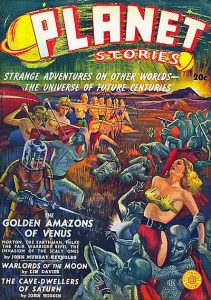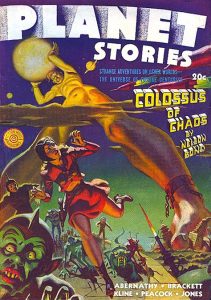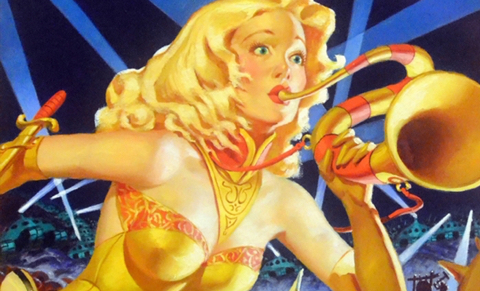 Although Fiction House had been around since the 1920s, it waited until 1939 to enter the science-fiction field. A year before, it had joined the comic book industry with Jumbo Comics, home to Sheena, “Queen of the Jungle.” Perhaps to hedge its bets, the publisher launched a science-fiction pulp, Planet Stories, and a science-fiction comic book, Planet Comics, at the same time.
Although Fiction House had been around since the 1920s, it waited until 1939 to enter the science-fiction field. A year before, it had joined the comic book industry with Jumbo Comics, home to Sheena, “Queen of the Jungle.” Perhaps to hedge its bets, the publisher launched a science-fiction pulp, Planet Stories, and a science-fiction comic book, Planet Comics, at the same time.
Over the years, Fiction House had developed a reputation for offering action-packed stories of adventure in its pulps. Planet Stories would prove to be no exception to this rule. Over its 71 issues, the rough-paper magazine would be home to countless science-fiction adventure stories called “space operas.”
In her introduction to The Best of Planet Stories #1, acclaimed author and screenwriter Leigh Brackett writes: “Planet, unashamedly, published “space opera” . . . . a story that has an element of adventure . . . . of great courage and daring, of battle against the forces of darkness and the unknown . . . The so-called space opera is the folk-tale, the hero-tale, of our particular niche in history . . . . These stories served to stretch our little minds, to draw us out beyond our narrow skies into the vast glooms of interstellar space, where the great suns ride in splendor and the bright nebulae fling their veils of fire parsecs-long across the universe; where the Coal-sack and the Horsehead make patterns of black mystery; where the Cepheid variables blink their evil eyes and a billion nameless planets may harbor life-forms infinitely numerous and strange.”
Running from 1939 to 1955, the early issues of Planet Stories featured writers such as Nelson Bond, Ray Cummings, John Russell Fearn, Neil R. Jones, Ed Earl Repp, and Ross Rocklynne. By the middle forties, Leigh Brackett and Ray Bradbury reigned supreme with the former offering seventeen “science fantasies,” while the latter introduced readers to his vision of Mars. They were joined by less-acclaimed authors such as Alfred Coppel, Gardner F. Fox, Henry Hasse, Carl Jacobi, Emmett McDowell, and Basil Wells. The late forties and early fifties found the magazine publishing work by Poul Anderson, James Blish, Philip K. Dick, Chad Oliver, Mack Reynolds, Theodore Sturgeon, Bryce Walton, and other greats who would help to develop science fiction’s modern era.
 Perhaps it was Planet Stories’ emphasis on cover art with a strong dose of sex—usually imagined by Allen Anderson or Frank Kelly Freas—that helped turn “space opera” into a pejorative term. Per Leigh Brackett, “It was fashionable for a while, among certain elements of science-fiction fandom, to hate Planet Stories. They hated the magazine, apparently, because it was not Astounding Stories.” For seventy-one issues, rather than aiming for the cerebrum, Planet Stories tugged at the heart. Who is to say that one target is more valid than the other?
Perhaps it was Planet Stories’ emphasis on cover art with a strong dose of sex—usually imagined by Allen Anderson or Frank Kelly Freas—that helped turn “space opera” into a pejorative term. Per Leigh Brackett, “It was fashionable for a while, among certain elements of science-fiction fandom, to hate Planet Stories. They hated the magazine, apparently, because it was not Astounding Stories.” For seventy-one issues, rather than aiming for the cerebrum, Planet Stories tugged at the heart. Who is to say that one target is more valid than the other?






